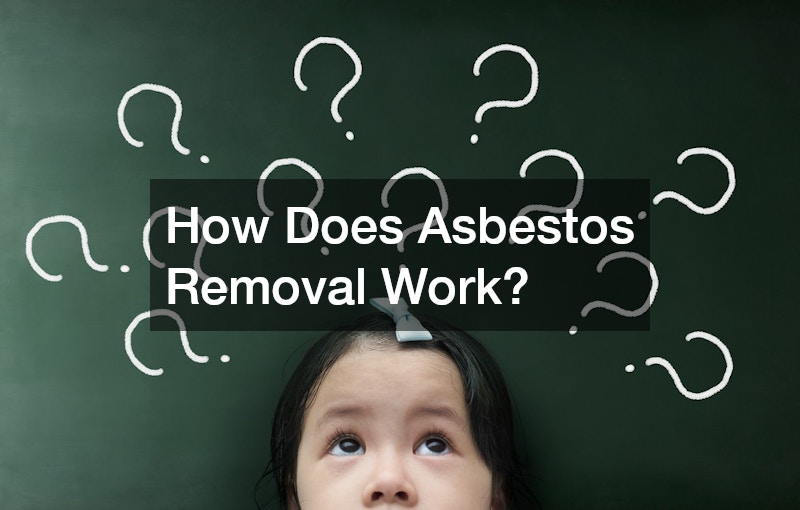Asbestos removal is a critical process for ensuring the safety of buildings that were constructed before the dangers of asbestos became widely known. Once heralded as a miracle material for its strength and fire resistance, asbestos has been linked to severe health issues, including lung cancer, asbestosis, and mesothelioma. Due to these risks, safely removing asbestos is highly regulated and requires a step-by-step process to prevent exposure and contamination. In this guide, we’ll explore how asbestos removal works, from the initial inspection to the final disposal of the hazardous material.
1. Initial Inspection and Risk Assessment
The first step in any asbestos removal project is a thorough inspection. Certified asbestos professionals, trained in handling hazardous materials, conduct the inspection to determine the presence of asbestos-containing materials (ACMs).
These could include insulation, flooring, roofing materials, or even textured paints.
The inspection involves sampling suspect materials and sending them to a laboratory for analysis. Once the samples have been tested and confirmed to contain asbestos, a risk assessment is conducted to evaluate the level of danger posed by the asbestos. Factors like the condition of the asbestos-containing material (whether it’s friable or non-friable) and the potential for exposure help to determine the removal plan.
2. Designing a Removal Plan
Once the extent and condition of the asbestos are determined, the next step is to design a detailed removal plan. This plan is tailored to the specific situation and will include strategies for containment, the type of equipment needed, and disposal methods. The plan also identifies safety measures for the removal team and the property occupants. This stage is critical as it ensures that no unnecessary risks are taken during the removal process.
The removal plan typically includes:
Isolating the work area with barriers or enclosures to prevent asbestos fibers from spreading.
Using specialized ventilation systems to maintain negative pressure inside the containment area.
Outlining procedures for safely removing and bagging asbestos-containing materials.
3. Preparing the Worksite
Before any removal work begins, the asbestos abatement team sets up the containment area. This involves sealing off the space where asbestos materials are located to ensure that fibers do not escape into other parts of the building. Polyethylene sheets, air-tight seals, and negative pressure units are commonly used to keep the work area contained and safe.
Occupants of the building, such as homeowners or workers, may be required to vacate the premises depending on the extent of the asbestos contamination. The removal team also establishes decontamination areas where workers can clean themselves and their equipment before exiting the site.
4. Removal of Asbestos-Containing Materials
With the site prepared and safety measures in place, the actual removal of asbestos begins. Asbestos removal specialists use protective gear, including full-body suits and respirators, to shield themselves from exposure. The removal process varies depending on the type and condition of the asbestos-containing material:
Friable Asbestos: Materials that can easily crumble and release fibers into the air (e.g., insulation) are the most dangerous and require careful handling. Workers wet the asbestos-containing materials to minimize the release of fibers during removal.
Non-friable Asbestos: Non-friable materials, like asbestos cement, are less likely to release fibers unless they are broken or damaged. These materials are removed with minimal disturbance to keep the fibers contained.
Asbestos-containing materials are removed in sections, carefully wrapped in plastic, and sealed in clearly labeled bags that meet regulatory standards for hazardous materials. This method ensures that no loose asbestos fibers remain on-site.
5. Decontamination Process
Once the asbestos is removed, the next step is to decontaminate the area. Any surfaces that may have come into contact with asbestos fibers, such as floors, walls, or equipment, are thoroughly cleaned. Workers use specialized vacuums equipped with HEPA filters to capture even the smallest particles.
The workers themselves also go through a decontamination process before leaving the worksite. This involves passing through decontamination chambers where they can remove and clean their protective gear and tools. Proper decontamination ensures that no asbestos fibers are transferred outside the containment area.
6. Final Air Quality Testing
After the removal and decontamination are complete, air quality testing is performed to ensure that no asbestos fibers remain in the air. This is a critical step in verifying that the removal was successful and that the area is safe for reoccupation.
Certified professionals use air sampling devices to collect air quality data, which is then analyzed in a laboratory. If the levels of asbestos in the air meet the safety standards set by regulatory agencies, the containment area is cleared, and the project can be considered complete.
7. Proper Disposal of Asbestos
Asbestos is classified as hazardous waste, and its disposal is tightly regulated. Once the asbestos-containing materials are sealed and bagged, they must be transported to a certified landfill that accepts asbestos waste. These landfills have special protocols in place to handle and bury asbestos materials safely to prevent future exposure.
Transporting asbestos also requires strict adherence to regulations, and only licensed waste transporters are allowed to move asbestos waste. The materials are accompanied by documentation that tracks their disposal from the removal site to the landfill.
Watch the video above to learn more about asbestos removal in Essex! .

